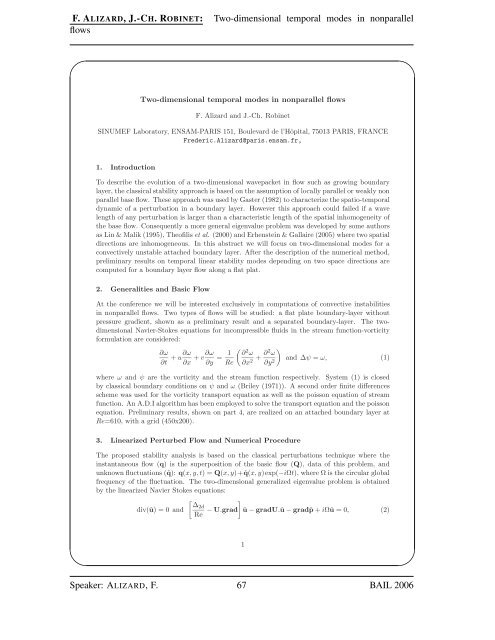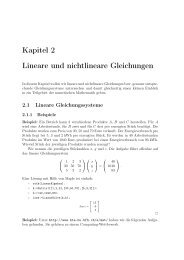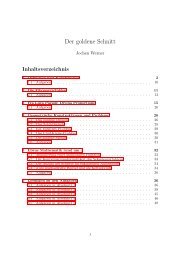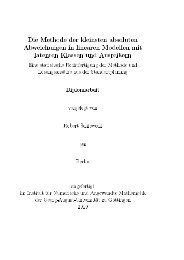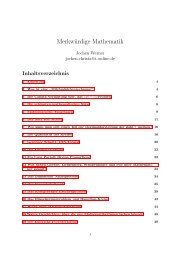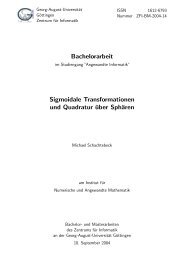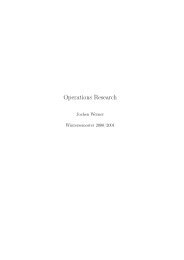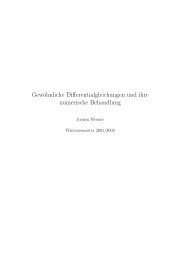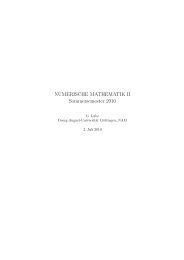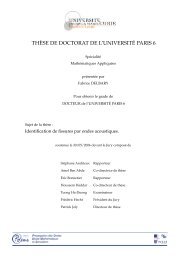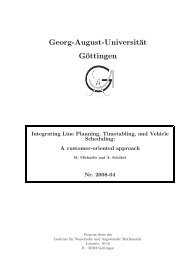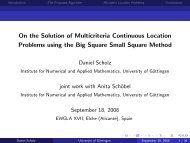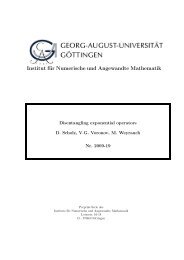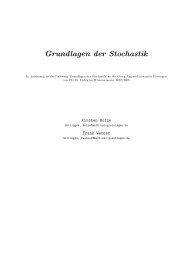BAIL 2006 Book of Abstracts - Institut für Numerische und ...
BAIL 2006 Book of Abstracts - Institut für Numerische und ...
BAIL 2006 Book of Abstracts - Institut für Numerische und ...
You also want an ePaper? Increase the reach of your titles
YUMPU automatically turns print PDFs into web optimized ePapers that Google loves.
F. ALIZARD, J.-CH. ROBINET: Two-dimensional temporal modes in nonparallel<br />
flows<br />
✬<br />
✫<br />
Two-dimensional temporal modes in nonparallel flows<br />
F. Alizard and J.-Ch. Robinet<br />
SINUMEF Laboratory, ENSAM-PARIS 151, Boulevard de l’Hôpital, 75013 PARIS, FRANCE<br />
Frederic.Alizard@paris.ensam.fr,<br />
1. Introduction<br />
To describe the evolution <strong>of</strong> a two-dimensional wavepacket in flow such as growing bo<strong>und</strong>ary<br />
layer, the classical stability approach is based on the assumption <strong>of</strong> locally parallel or weakly non<br />
parallel base flow. These approach was used by Gaster (1982) to characterize the spatio-temporal<br />
dynamic <strong>of</strong> a perturbation in a bo<strong>und</strong>ary layer. However this approach could failed if a wave<br />
length <strong>of</strong> any perturbation is larger than a characteristic length <strong>of</strong> the spatial inhomogeneity <strong>of</strong><br />
the base flow. Consequently a more general eigenvalue problem was developed by some authors<br />
as Lin & Malik (1995), The<strong>of</strong>ilis et al. (2000) and Erhenstein & Gallaire (2005) where two spatial<br />
directions are inhomogeneous. In this abstract we will focus on two-dimensional modes for a<br />
convectively unstable attached bo<strong>und</strong>ary layer. After the description <strong>of</strong> the numerical method,<br />
preliminary results on temporal linear stability modes depending on two space directions are<br />
computed for a bo<strong>und</strong>ary layer flow along a flat plat.<br />
2. Generalities and Basic Flow<br />
At the conference we will be interested exclusively in computations <strong>of</strong> convective instabilities<br />
in nonparallel flows. Two types <strong>of</strong> flows will be studied: a flat plate bo<strong>und</strong>ary-layer without<br />
pressure gradient, shown as a preliminary result and a separated bo<strong>und</strong>ary-layer. The twodimensional<br />
Navier-Stokes equations for incompressible fluids in the stream function-vorticity<br />
formulation are considered:<br />
∂ω<br />
∂ω 1<br />
+ u∂ω + v =<br />
∂t ∂x ∂y Re<br />
�<br />
∂2ω ∂x2 + ∂2ω ∂y2 �<br />
and ∆ψ = ω, (1)<br />
where ω and ψ are the vorticity and the stream function respectively. System (1) is closed<br />
by classical bo<strong>und</strong>ary conditions on ψ and ω (Briley (1971)). A second order finite differences<br />
scheme was used for the vorticity transport equation as well as the poisson equation <strong>of</strong> stream<br />
function. An A.D.I algorithm has been employed to solve the transport equation and the poisson<br />
equation. Preliminary results, shown on part 4, are realized on an attached bo<strong>und</strong>ary layer at<br />
Re=610, with a grid (450x200).<br />
3. Linearized Perturbed Flow and Numerical Procedure<br />
The proposed stability analysis is based on the classical perturbations technique where the<br />
instantaneous flow (q) is the superposition <strong>of</strong> the basic flow (Q), data <strong>of</strong> this problem, and<br />
unknown fluctuations (ˆq): q(x, y, t) =Q(x, y)+ˆq(x, y)exp(−iΩt), where Ω is the circular global<br />
frequency <strong>of</strong> the fluctuation. The two-dimensional generalized eigenvalue problem is obtained<br />
by the linearized Navier Stokes equations:<br />
� �<br />
∆2d<br />
div(û) = 0 and − U.grad û − gradU.û − gradˆp + iΩû =0, (2)<br />
Re<br />
1<br />
Speaker: ALIZARD, F. 67 <strong>BAIL</strong> <strong>2006</strong><br />
✩<br />
✪


